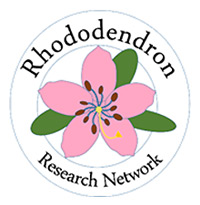
Rhododendron Research Network
Rhododendron Hybrid Pedigree Search
Introduction
The rhododendron hybrid
pedigree search enables researchers to select hybrids that have a specific
species or hybrid parent. The searchable database consists of 1150
rhododendron hybrids that are
available from commercial sources. Any combination of seed or pollen and
species or hybrid parent in a desired generation (i.e., 1st, 2nd, 3rd, 4th, or
5th) can be selected. A parentage tree is provided for each hybrid
cultivar that satisfies the search criteria.
Research Application
Hybrids are
an important tool for genetics research because the outcomes of hybridization allow us to determine
the segregation of alleles. The classic work by Gregor Mendel, who investigated pea hybrids, was the first to use
hybrids in this manner. Nowadays, geneticists are also interested in the distortion of Mendelian transmission,
i.e. cases where offspring of heterozygous parents do not carry either allele with equal probability.
Pedigrees are an excellent tool for designing experiments with hybrids. Comparing the phenotype of parents with that of offspring in the F1 and F2 generations can be the first step to determining which genes are responsible for a trait, and the genetic mechanisms of inheritance (e.g. transmission distortion, gene dominance and dosage effects). Genome-wide association studies, which involve scanning whole genomes for candidate genes, can also incorporate pedigrees to inform analysis, allowing a more targeted approach to increase the speed of discovery.
Pedigrees themselves can also be used as data. For example, to build a recombination map, which reveals the relative influence of genetic linkages versus independent assortment, and has important consequences for inheritance. This information can also be used to discern the location and order of genes on the chromosomes.
In addition, pedigrees can be used in combination with genotypic and phenotypic data to understand how populations change over time, and to reveal patterns and processes related to genetic diversity. For example, in determining how patterns of gene flow have contributed to population decline, or how deleterious alleles and small population sizes contribute to disease susceptibility.
To Search Click Link ► Rhododendron Parentage Search